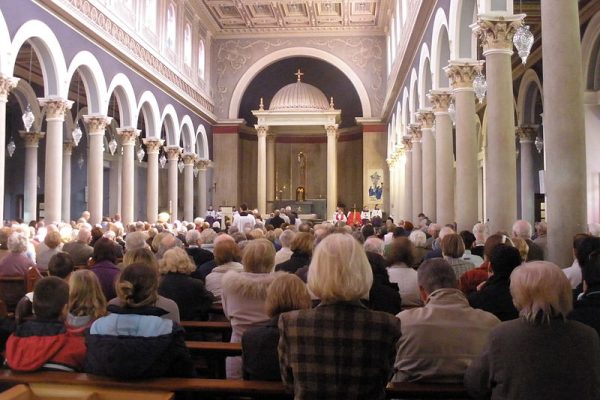Home>Special Themes>What Is Advent Reconciliation Service Catholic


Special Themes
What Is Advent Reconciliation Service Catholic
Published: February 13, 2024
Jason DeRose, Managing Editor at Christian.net, uses his expertise in religion and journalism to deepen understanding of faith's societal impacts. His editorial leadership, coupled with a strong academic background, enriches the platform’s diverse content, earning him recognition in both journalism and religious circles.
Learn about the significance and traditions of the Advent Reconciliation Service in the Catholic Church. Explore the special themes and practices associated with this sacred event.
(Many of the links in this article redirect to a specific reviewed product. Your purchase of these products through affiliate links helps to generate commission for Christian.net, at no extra cost. Learn more)
Table of Contents
- Introduction
- Understanding Advent in the Catholic Church
- The Importance of Reconciliation in Advent
- What to Expect at an Advent Reconciliation Service
- How to Prepare for an Advent Reconciliation Service
- The Role of the Priest in the Reconciliation Service
- Benefits of Participating in Advent Reconciliation
- Conclusion
Introduction
Advent is a significant and sacred time in the Catholic Church, marking the beginning of the liturgical year and the anticipation of the birth of Jesus Christ. It is a period of joyful expectation, spiritual preparation, and reflection on the coming of the Messiah. Within the context of Advent, the Catholic Church emphasizes the themes of hope, peace, joy, and love, inviting believers to deepen their faith and embrace the transformative power of Christ's presence in their lives.
As part of the Advent season, the Catholic Church offers various spiritual practices and rituals to help the faithful prepare their hearts and minds for the celebration of Christmas. One such practice is the Advent Reconciliation Service, a profound and meaningful opportunity for individuals to seek forgiveness, experience spiritual healing, and renew their relationship with God.
During this sacred time, Catholics are encouraged to engage in acts of repentance, self-examination, and reconciliation, aligning their lives with the teachings of Christ and the values of the Gospel. The Advent Reconciliation Service serves as a pivotal moment for believers to acknowledge their shortcomings, seek absolution for their sins, and experience the restorative grace of God's mercy.
In the following sections, we will delve into the significance of Advent in the Catholic Church, the importance of reconciliation during this season, what to expect at an Advent Reconciliation Service, how to prepare for this sacred encounter, the role of the priest in facilitating reconciliation, and the profound benefits of participating in this spiritual practice. By exploring these aspects, we aim to provide a comprehensive understanding of the Advent Reconciliation Service and its profound impact on the spiritual journey of Catholic believers.
Understanding Advent in the Catholic Church
Advent, derived from the Latin word "adventus," meaning "coming" or "arrival," holds a special place in the liturgical calendar of the Catholic Church. It encompasses the four weeks leading up to Christmas and serves as a period of spiritual preparation, anticipation, and joyful expectation for the birth of Jesus Christ. This sacred season not only commemorates the historical event of Christ's nativity but also symbolizes the profound spiritual truth of Christ's ongoing presence in the lives of believers.
The observance of Advent is characterized by a sense of hopeful waiting and active readiness. It invites Catholics to reflect on the significance of Christ's incarnation, his first coming as a humble infant, and to prepare their hearts to receive him anew. The liturgical color of Advent, symbolizing anticipation and hope, is purple, signifying the penitential nature of the season, as well as the royalty of the coming King. In some traditions, a pink candle is lit on the third Sunday of Advent, known as Gaudete Sunday, symbolizing joy and rejoicing in the nearness of the Savior's birth.
Central to the observance of Advent are the themes of hope, peace, joy, and love, which are represented by the four candles of the Advent wreath. Each week, a new candle is lit, signifying the progressive illumination of the world by the light of Christ. The wreath itself, often adorned with evergreen branches, symbolizes the eternal life found in Christ and the unending love of God.
In addition to the visual and symbolic elements, the liturgical readings during Advent focus on the prophecies of the Messiah, the anticipation of his coming, and the call to spiritual vigilance. These readings serve as a spiritual guide, directing believers to reflect on the promises of God, the fulfillment of ancient prophecies in Christ, and the ultimate hope found in the redemptive work of the Savior.
The observance of Advent in the Catholic Church is not merely a historical reenactment but a profound spiritual journey that invites believers to enter into the mystery of Christ's incarnation, to prepare their hearts for his coming, and to renew their commitment to living as faithful disciples. It is a time of prayer, reflection, and spiritual renewal, calling the faithful to embrace the transformative power of Christ's presence in their lives and to prepare for his second coming with hopeful expectation and joyful anticipation.
The Importance of Reconciliation in Advent
The significance of reconciliation during the Advent season cannot be overstated in the Catholic Church. As believers prepare to celebrate the birth of Jesus Christ, the sacrament of reconciliation, also known as confession, holds profound importance. It serves as a spiritual opportunity for individuals to seek forgiveness for their sins, experience healing, and renew their relationship with God.
During Advent, the call to reconciliation aligns with the themes of hope, peace, joy, and love. It invites Catholics to engage in self-examination, repentance, and the restoration of their spiritual well-being. The act of reconciliation acknowledges human frailty and the need for divine mercy, fostering a sense of humility and contrition. By seeking reconciliation, individuals open themselves to the transformative grace of God, allowing them to shed the burdens of sin and embrace the promise of spiritual renewal.
Moreover, the sacrament of reconciliation offers a profound sense of liberation and inner peace. As individuals confess their sins to a priest, they experience the liberating power of forgiveness, releasing the weight of guilt and shame. This process of confession and absolution brings about a deep sense of spiritual healing, allowing believers to reconcile with themselves, others, and God. It fosters a renewed sense of hope and joy, enabling individuals to approach the celebration of Christ's birth with a cleansed heart and a restored relationship with the divine.
Furthermore, the practice of reconciliation during Advent underscores the foundational Christian values of mercy and compassion. It reflects the teachings of Jesus Christ, who exemplified unconditional love and forgiveness. By engaging in the sacrament of reconciliation, individuals embody the spirit of reconciliation and mercy, mirroring the redemptive love of Christ in their own lives. This act of humility and repentance not only strengthens the individual's relationship with God but also fosters a spirit of reconciliation within the broader community, promoting unity, understanding, and forgiveness.
In essence, the importance of reconciliation in Advent lies in its capacity to facilitate spiritual renewal, foster inner peace, and deepen the individual's connection with God. It embodies the core principles of the Advent season, inviting believers to embrace the transformative power of forgiveness, experience the restorative grace of God's mercy, and approach the celebration of Christ's birth with hearts renewed and spirits uplifted.
What to Expect at an Advent Reconciliation Service
At an Advent Reconciliation Service, participants can anticipate a deeply meaningful and spiritually enriching experience. The service typically begins with a reverent and reflective atmosphere, setting the tone for introspection and reconciliation. Upon entering the sacred space, individuals are greeted with a sense of tranquility and reverence, creating an environment conducive to prayer and self-examination.
The service often commences with communal prayers, scripture readings, and hymns that center on themes of repentance, forgiveness, and the transformative power of God's mercy. These elements serve to prepare the hearts and minds of the participants, guiding them towards a state of openness and receptivity to the grace of reconciliation.
As the service progresses, individuals are invited to engage in a period of silent reflection, allowing them to examine their conscience and acknowledge areas in their lives where reconciliation is needed. This introspective phase provides an opportunity for personal examination and the recognition of one's own shortcomings, fostering a spirit of humility and contrition.
Following the period of reflection, the sacrament of reconciliation is typically offered, providing participants with the opportunity to confess their sins and seek absolution. Priests are available to listen, offer guidance, and extend the sacrament of reconciliation to those seeking spiritual healing and renewal. The encounter with the priest during this sacramental moment is characterized by confidentiality, compassion, and the assurance of God's unconditional love and forgiveness.
Participants can expect to experience a profound sense of liberation and inner peace as they receive the sacrament of reconciliation. The act of confessing one's sins, receiving absolution, and offering prayers of penance brings about a transformative sense of spiritual healing and renewal. This process allows individuals to release the burdens of guilt and shame, embracing the restorative grace of God's mercy and experiencing a renewed sense of hope and joy.
In addition to the sacramental encounter, the service may also include moments of communal prayer, reflection, and the opportunity for individuals to express gratitude for the gift of reconciliation. The communal aspect of the service fosters a sense of solidarity and shared spiritual journey, reinforcing the understanding that all individuals are in need of God's mercy and forgiveness.
Overall, participants can expect an encounter with the profound and transformative grace of God's mercy, a sense of spiritual renewal, and a deepened connection with the divine. The Advent Reconciliation Service offers a sacred space for individuals to seek forgiveness, experience healing, and embrace the promise of reconciliation, preparing their hearts to joyfully welcome the birth of Jesus Christ.
How to Prepare for an Advent Reconciliation Service
Preparing for an Advent Reconciliation Service involves a deliberate and introspective approach to spiritual readiness. As believers anticipate this sacred encounter, there are several meaningful steps they can take to prepare their hearts and minds for the experience of reconciliation.
-
Self-Examination: Prior to attending the Reconciliation Service, individuals are encouraged to engage in a period of self-examination. This involves reflecting on their thoughts, words, and actions, and honestly assessing areas where they may have fallen short of living in accordance with the teachings of Christ. Self-examination fosters a spirit of humility and contrition, preparing individuals to approach the sacrament of reconciliation with sincerity and openness.
-
Prayer and Reflection: Engaging in prayer and reflection is essential in preparing for the Reconciliation Service. Through prayer, individuals can seek guidance, express contrition for their sins, and open their hearts to the transformative grace of God's mercy. Reflecting on the ways in which they have strayed from God's will allows individuals to acknowledge their need for reconciliation and spiritual healing.
-
Examination of Conscience: Taking time to conduct an examination of conscience is a vital aspect of preparation. This involves reviewing one's actions in light of the Ten Commandments, the Beatitudes, and the teachings of the Church. By honestly assessing their behaviors and attitudes, individuals can identify areas in need of reconciliation and prepare to make a sincere confession during the service.
-
Acts of Penance: Engaging in acts of penance prior to the Reconciliation Service demonstrates a genuine desire for spiritual renewal. This may involve performing acts of charity, seeking reconciliation with others, or making amends for past wrongs. By embracing acts of penance, individuals demonstrate their commitment to turning away from sin and embracing the path of reconciliation.
-
Spiritual Guidance: Seeking spiritual guidance from a trusted mentor, spiritual director, or the parish priest can provide valuable support in preparing for the Reconciliation Service. Guidance from a knowledgeable and compassionate source can offer clarity, encouragement, and insight as individuals navigate their spiritual journey towards reconciliation.
By embracing these preparatory steps, individuals can approach the Advent Reconciliation Service with a spirit of humility, openness, and sincere contrition. This intentional preparation allows believers to fully engage in the transformative experience of seeking forgiveness, receiving absolution, and embracing the restorative grace of God's mercy.
Read more: What Is Advent Catholic
The Role of the Priest in the Reconciliation Service
The priest plays a pivotal and sacred role in facilitating the Reconciliation Service during the Advent season in the Catholic Church. As a minister of the sacrament of reconciliation, the priest embodies the compassionate presence of Christ and serves as a conduit for the transformative grace of God's mercy.
First and foremost, the priest serves as a compassionate listener and guide, creating a safe and confidential space for individuals to express their contrition and seek forgiveness. Through active listening and empathetic understanding, the priest offers a non-judgmental presence, allowing individuals to openly share their struggles, regrets, and desires for spiritual healing. This compassionate stance reflects the unconditional love and mercy of Christ, inviting individuals to experience the liberating power of confession and absolution.
In addition to listening, the priest provides spiritual counsel and guidance, offering insights and encouragement tailored to the individual's unique spiritual journey. Through gentle guidance and pastoral care, the priest assists individuals in examining their conscience, identifying areas in need of reconciliation, and discerning practical steps towards spiritual renewal. This supportive role empowers individuals to navigate the process of confession with sincerity and authenticity, fostering a deeper sense of self-awareness and spiritual growth.
Moreover, the priest administers the sacrament of reconciliation, serving as an instrument of God's mercy and forgiveness. As individuals confess their sins, the priest, acting in persona Christi, extends the words of absolution, imparting the restorative grace of God and reconciling the penitent with the divine. This sacred moment of absolution brings about a profound sense of spiritual healing and renewal, allowing individuals to experience the transformative power of God's mercy in a tangible and deeply personal way.
Furthermore, the priest encourages individuals to embrace acts of penance as a means of expressing their genuine desire for spiritual renewal and reconciliation. By offering practical and meaningful penitential actions, the priest guides individuals towards a deeper understanding of the transformative nature of reconciliation, inspiring them to integrate the grace of forgiveness into their daily lives.
In essence, the role of the priest in the Reconciliation Service embodies the compassionate, guiding, and sacramental dimensions of Christ's ministry of reconciliation. Through their compassionate listening, spiritual guidance, administration of the sacrament, and encouragement of penitential acts, priests play a vital role in facilitating the transformative encounter with God's mercy, enabling individuals to experience the profound joy of reconciliation and spiritual renewal during the Advent season.
Benefits of Participating in Advent Reconciliation
Participating in Advent Reconciliation offers a myriad of profound benefits that deeply enrich the spiritual journey of individuals within the Catholic Church. This sacred practice, rooted in the themes of hope, peace, joy, and love, holds transformative power, fostering spiritual renewal, inner peace, and a deepened connection with God.
One of the primary benefits of engaging in Advent Reconciliation is the experience of spiritual healing and liberation. Through the sacrament of reconciliation, individuals have the opportunity to unburden themselves from the weight of sin, guilt, and shame. Confessing one's sins and receiving absolution brings about a profound sense of inner peace, allowing individuals to experience the liberating grace of God's mercy. This process of reconciliation enables participants to release the burdens of the past, embracing the promise of spiritual renewal and a restored relationship with the divine.
Furthermore, participating in Advent Reconciliation cultivates a heightened sense of self-awareness and personal growth. Engaging in self-examination, reflection, and the act of confessing one's sins fosters a spirit of humility, contrition, and genuine introspection. This process encourages individuals to confront their shortcomings, acknowledge areas in need of reconciliation, and embrace a path of spiritual growth. By engaging in this transformative practice, participants gain a deeper understanding of their own humanity and the transformative power of God's grace in their lives.
Moreover, the act of participating in Advent Reconciliation fosters a renewed sense of hope, joy, and spiritual vitality. As individuals seek forgiveness and experience the restorative grace of God's mercy, they are infused with a profound sense of hope and joy. The assurance of God's unconditional love and forgiveness brings about a renewed sense of spiritual vitality, enabling participants to approach the celebration of Christ's birth with hearts uplifted and spirits rejuvenated.
Additionally, engaging in the sacrament of reconciliation during Advent strengthens the individual's relationship with God and fosters a deeper sense of unity within the faith community. By seeking forgiveness and embracing the transformative grace of reconciliation, individuals deepen their connection with the divine, fostering a sense of spiritual intimacy and trust in God's mercy. Furthermore, the communal aspect of the Reconciliation Service promotes a spirit of solidarity and shared spiritual journey, reinforcing the understanding that all individuals are in need of God's mercy and forgiveness.
In essence, participating in Advent Reconciliation offers individuals a transformative encounter with the restorative grace of God's mercy, fostering spiritual healing, personal growth, renewed hope, and a deepened connection with the divine and the faith community. This sacred practice serves as a profound opportunity for individuals to experience the transformative power of reconciliation, preparing their hearts to joyfully welcome the birth of Jesus Christ.
Conclusion
In conclusion, the Advent Reconciliation Service holds profound significance within the Catholic Church, offering believers a sacred opportunity to engage in the transformative power of reconciliation during the Advent season. As individuals prepare to celebrate the birth of Jesus Christ, the practice of seeking forgiveness, experiencing spiritual healing, and renewing one's relationship with God through the sacrament of reconciliation embodies the core themes of hope, peace, joy, and love that define the Advent season.
Throughout the Advent Reconciliation Service, participants can expect a deeply meaningful and spiritually enriching experience. The service provides a reverent and reflective atmosphere, guiding individuals towards a state of openness and receptivity to the grace of reconciliation. Through communal prayers, scripture readings, and moments of silent reflection, participants are invited to engage in self-examination, acknowledge their need for reconciliation, and prepare their hearts to receive the restorative grace of God's mercy.
Preparation for the Reconciliation Service involves intentional steps, including self-examination, prayer, reflection, examination of conscience, acts of penance, and seeking spiritual guidance. These preparatory measures enable individuals to approach the sacrament of reconciliation with sincerity, humility, and a genuine desire for spiritual renewal.
The role of the priest in the Reconciliation Service is pivotal, as they embody the compassionate, guiding, and sacramental dimensions of Christ's ministry of reconciliation. Through compassionate listening, spiritual guidance, administration of the sacrament, and encouragement of penitential acts, priests facilitate a transformative encounter with God's mercy, enabling individuals to experience the profound joy of reconciliation and spiritual renewal.
Participating in Advent Reconciliation offers a myriad of profound benefits, including spiritual healing, personal growth, renewed hope, and a deepened connection with God and the faith community. The experience of seeking forgiveness and embracing the restorative grace of reconciliation infuses individuals with a profound sense of hope, joy, and spiritual vitality, preparing their hearts to joyfully welcome the birth of Jesus Christ.
In essence, the Advent Reconciliation Service serves as a sacred and transformative practice that enables individuals to shed the burdens of sin, embrace the promise of spiritual renewal, and approach the celebration of Christ's birth with hearts uplifted and spirits rejuvenated. It embodies the core principles of the Advent season, inviting believers to experience the transformative power of reconciliation and the restorative grace of God's mercy, fostering a renewed sense of hope, joy, and spiritual vitality as they prepare to welcome the birth of Jesus Christ.














